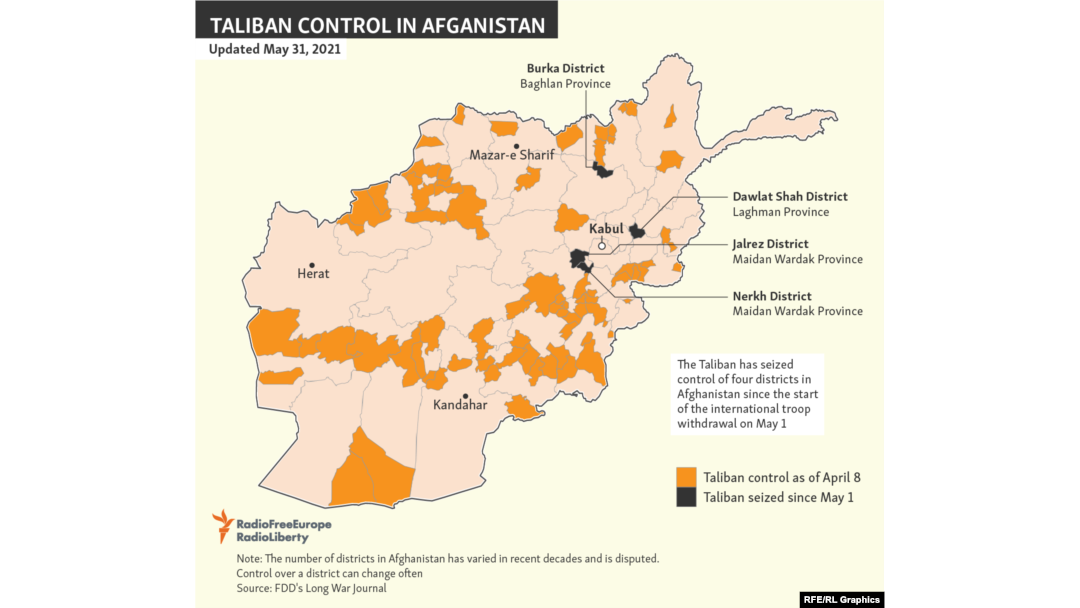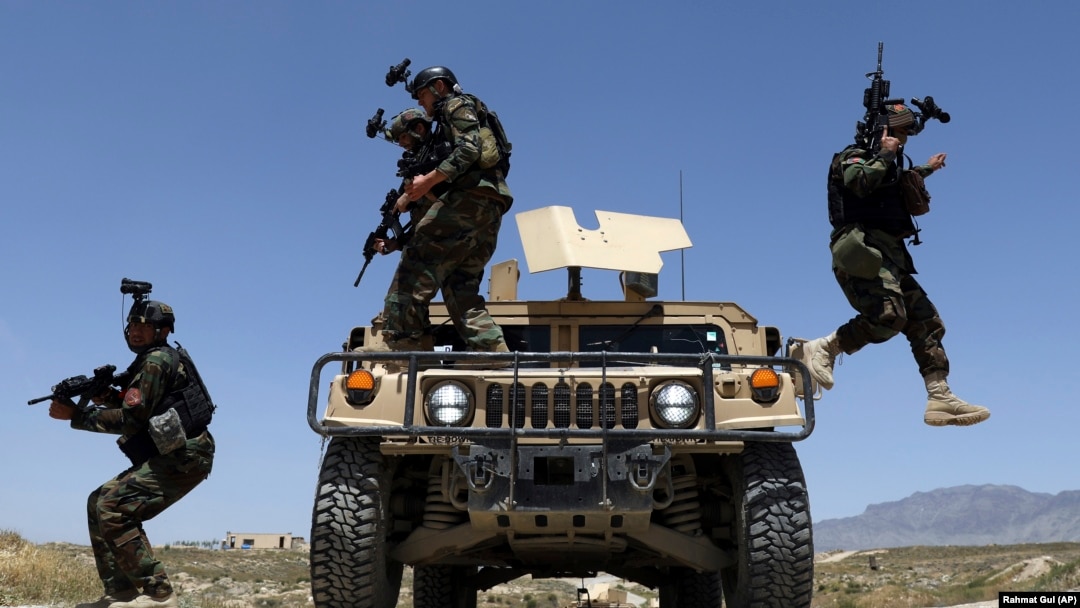Since the start of the international military withdrawal on May 1, the Taliban has seized strategic districts near the capital, Kabul, overrun military sites, and besieged towns and cities across Afghanistan.
The Taliban’s early military gains have fueled fears that it could topple the Western-backed Afghan government and its battered security forces once all foreign forces depart by September.
It is unclear if the militant group is attempting a forcible takeover of Afghanistan or just trying to boost its leverage in deadlocked peace talks aimed at striking a permanent cease-fire and power-sharing arrangement.
Intra-Afghan talks that began in September have made little progress, hampered by deep mistrust, militant violence, and a huge gulf between the Taliban and Afghan representatives on key issues. In a further blow, the insurgents last month backed out of a high-level international peace conference hosted by Turkey.

Observers say U.S. President Joe Biden's April decision to pull out the remaining 3,500 American troops in Afghanistan without setting any conditions has removed any incentive for the Taliban to pursue real peace. Around 7,000 other NATO forces are also departing with the U.S. troops.
In the wake of Biden’s decision, the Taliban immediately intensified attacks on provincial capitals, district centers, and large government military bases.
“In a maximalist sense, the Taliban wants a total military victory,” says Tamim Asey, the head of the Institute of War and Peace Studies, a Kabul-based think tank.
“In a minimalist sense, once the Taliban has tested government forces and realized that a total military victory is not within reach then it will use violence as leverage to secure further concessions at the negotiation table,” adds Asey, a former Afghan deputy defense minister.
‘Fall Of Districts’
The militants have launched major offensives in both the country’s north and south. There has also been an uptick in deadly suicide bombings striking urban areas that have been blamed on the Islamist group.
An Afghan man lies at a hospital after clashes between the Taliban and Afghan security forces in Laghman Province, east of Kabul, on May 24.
During the past month, the Taliban has seized control of at least four districts across Afghanistan: in Jalrez and Nerkh in the central province of Maidan Wardak, Dawlat Shah in the eastern province of Laghman, and Burka in the northern province of Baghlan.
The militants also briefly overran the Baghlan-e Jadid district in Baghlan and the Almar district in northwestern Faryab Province.
Maidan Wardak is only 40 kilometers from Kabul and considered a gateway to the capital. Several key highways to the country’s central and southern provinces also go through Maidan Wardak.
“The fall of districts is nothing new, but the Taliban’s attacks on select strategic districts in the southern and eastern provinces surrounding Kabul is significant,” says Asey. “The Taliban has adopted a strategy of striking economic and military choke points around major Afghan cities. This is intended to cut off cities from the rest of the country and eventually seize them.”
SEE ALSO: Chances For Peace In Afghanistan Recede As Deadly Taliban Attacks Spiral
Bill Roggio, a senior fellow at the Foundation for Defense Of Democracies (FDD) and editor of the Long War Journal (LWJ), which tracks militant groups, says the Taliban is laying the groundwork for a “big push” to retake the country by force once all foreign forces leave.
“The Taliban can mass more forces in the field once U.S. airpower is gone,” says Roggio. “The Taliban is going to push to take large areas of the south and east, secure the passage to Kabul, maintain pressure on provinces surrounding the capital, all the while continuing to fight in the north and west to keep Afghan forces occupied.”
Around 24 percent of Afghanistan’s 398 districts are in government hands, the Taliban commands some 22 percent, and the rest are contested, according to the LWJ.
The LWJ’s “living map,” based mostly on media reports, is the only publicly available source that tracks district control in Afghanistan. NATO no longer assesses territorial control, and the Afghan government has classified its own data.
Afghan security officials present arrested members of the Taliban on the outskirts of Ghazni on May 29.
The Afghan government controls the capital, Kabul, provincial capitals, major population centers, and most district centers. The Taliban -- which controls more territory than any other time since the U.S.-led invasion in 2001 toppled it from power -- commands large swaths of the countryside.
‘Demoralization’
In some cases, the Taliban has seized military bases and district centers after fierce clashes with Afghan security forces, who have complained about overdue salaries, shortages of ammunition, and delays in sending air and ground reinforcements.
In other cases, the militants have seized control of military posts and districts without firing a bullet. In a growing trend, the Taliban, with the help of local elders, has negotiated the surrender of hundreds of Afghan soldiers and national police in the provinces of Laghman, Maidan Wardak, and Baghlan in recent weeks.
An Afghan security official stands guard at a check point in restive Laghman Province on May 25.
Such actions have allowed the militants to stock up on weapons, ammunition, and equipment. It has also been a propaganda coup for the Taliban, which has boasted of an impending victory in its recent statements.
Last week, the Taliban briefly entered Mehtarlam, the capital of Laghman Province, after government forces deserted several outposts protecting the city.
The Taliban was pushed out but later showed off weapons and equipment allegedly left behind at the outposts. More than 100 military personnel were arrested for negligence and moved to Kabul.
“The fall of these districts is due to demoralization, bad leadership, and dwindling resources and air support,” says Asey. “This is augmented by Taliban influence operations in which local elders and religious leaders are used to convince Afghan forces to surrender or defect.”
Morale among government forces has reportedly sunk since the announcement of the full international military withdrawal.
Observers say the military exit will severely weaken Afghanistan’s security forces, which have relied heavily on U.S. air support, intelligence, and logistics to keep the Taliban at bay.
The United States has pledged to continue funding the 273,000-strong Afghan National Army and Afghan National Police. Washington has also said Afghan forces will receive military backing from U.S. bases and ships located hundreds of miles away -- the so-called "over the horizon” support.
But it is unclear if U.S. drones and war planes will aid Afghan forces fighting the Taliban or focus on counterterrorism missions against Al-Qaeda and Islamic State militants in Afghanistan.
“The Afghan military has been steadily losing ground to the Taliban even while U.S. forces were in country,” says Roggio. “Now, there is little the U.S. can do to help except for on the margins.”


